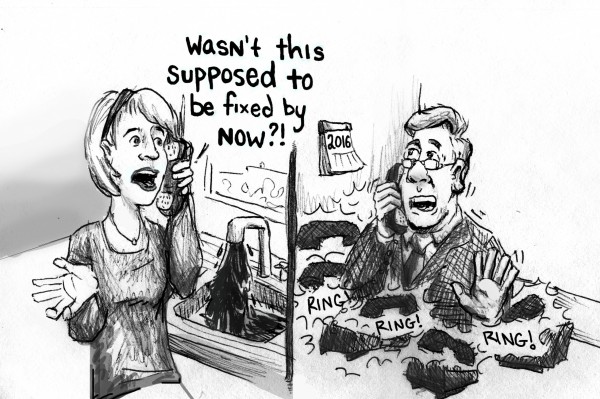
The Town and Village of New Paltz has been seeking an alternative water source for when the Catskill Aqueduct closes for maintenance repairs in 2016. Their efforts have been ongoing since August of 2013 when the Town and Village Board made a joint decision to shut down this aqueduct for a 10-week period in order to repair leaks and perform routine inspections. Recently the village has tapped into a Plains Road site in search of quality water, resulting in the tampering of 20 households’ well supply in the process.
The most recent test pumping involving these households had resulted in nearly 20 complaints of sulfuric tasting and smelling water, loss of water pressure in homes and excessive presence of coliform and lead in the water. Due to the homeowners’ uncertainty about the safety of their well water supply, many have covered the cost of hiring their own geo-hydrologists to ensure that they aren’t going to fall sick due to the tainted water.
We at The New Paltz Oracle believe that although these efforts are showing that the village is making progress with this problem, intruding upon homeowners’ water supplies, personal finances and health is very troubling at this point in time because officials have still not secured a suitable water supply for the community to fall back on in 2016.
Knowing how long of a process the exploratory drilling can be, it is difficult to hold confidence that a solution to this water supply issue will be seen anytime within the next few months, and even before 2015. With water being an absolute necessity, it is shocking that the nearly $850,000 in grants already presented for this project by New York City’s Department of Environmental Protection (DEP) are not being utilized more efficiently to find an alternative water source in a more timely manner.
Considering that this quest for securing an alternative supply began back in 2004 when the need was less urgent, we believe that 10 years in the making is far too long to not have a backup plan for an aqueduct that could at some point possibly stop working altogether if it is already in dire need of repairs. By the time 2016 comes around and it is time for the aqueduct to close, who is to say that we won’t already be facing a far larger issue of having to limit water supply because our current supply is diminishing or becomes tainted as well?
With this issue, the health and safety of the citizens is our main priority. If these test drills continue to intrude upon entire neighborhoods and put citizens of New Paltz at risk by exposing their drinking water with lead, then the DEP needs to conjure another plan to identify a less harmful alternative within their efforts.
Though lead is rarely found in source water, when it becomes present it can cause a variety of health effects, most notably in babies and children, such as delays in physical and mental development along with deficits in attention span and learning abilities.
If test drillings resulting in these problems continue, we are going to have a much larger problem on our hands as a town than just having our water shut down by 2016.
New Paltz has always prided itself on being a more “green” and eco-friendly area of the Hudson Valley, thoroughly implementing electric car chargers and solar panels. Even on the SUNY campus alone, students come together often in efforts to stop anything positioned as harmful toward the environment. As a town, we need to follow this initiative and express to the DEP that tainting the water supplies of citizens and being at a vulnerable position for more of this to occur is unacceptable.
City officials have reported that this aqueduct supplies between 700,000 and 1 million gallons of water a day with 70,000 of these gallons allocating to New Paltz’s usage alone. As of right now, a date has yet to be set for when the aqueduct will officially be shut down, which needs to change. People at this current moment are being subjected to runaround tactics imposing on their health and safety and still do not see any progress in identifying a backup source for when the shutdown is implemented.
A discussion concerning how safe and ethical these conducted drill tests really are needs to be held. If households have already been subjected to these conditions and a solution has not been found in our water supply crisis, then the efforts may be moving elsewhere into other neighborhoods where more people will potentially be negatively affected as well.
The village and DEP need to further investigate the methods that are being used in securing a backup water supply and design a less intrusive way to do so. In turn, this will aid in ensuring that both the citizens of New Paltz are safe and will not be left living off of bottled water for 10 weeks by the time the aqueduct is ultimately shut down.
